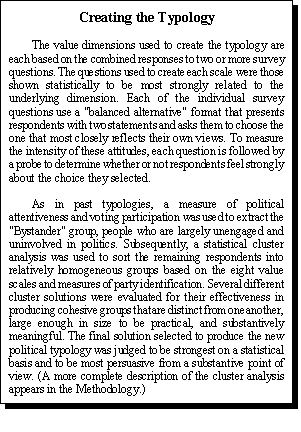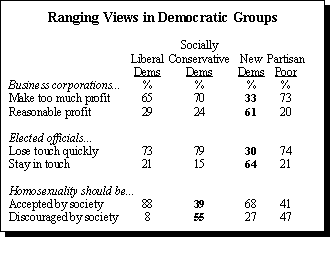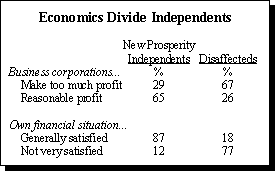The mood of the American electorate has changed markedly since the mid-1990s, with today’s political landscape reflecting good economic times and fresh optimism about the country. These changes are underscored by a new political typology, the third of its kind since the original study conducted in 1987. Many of the groups identified by the extensive public opinion survey are similar to those of past typologies, reflecting the continuing importance of a number of key beliefs and values among some segments of the electorate. But an easing of both the financial pressures and the anti-government sentiment of the mid-1990s has also produced several new groups — within each of the two parties — that are marked by their optimism and mainstream views.
Each of the typologies developed by the Center has been designed to provide a more complete and detailed description of the political landscape, classifying people on the basis of a broad range of value orientations rather than simply on the basis of party identification. Like past surveys, the new typology reveals substantial political and social differences within as well as across the two political parties. It also provides insights into the political attitudes of Independents, who make up more than one-third of the American electorate.

The New Typology
As in 1994, the new typology divides the public into ten groups defined by their attitudes toward government and politics and a range of other social, economic and religious beliefs. In addition to partisan leanings, the typology is based on eight value orientations, each of which is reflected by a scale based on two or more questions in the survey. They are as follows:
Environmentalism. Attitudes concerning environmental protection and the costs or benefits of environmental regulations.
Religion and Morality. Attitudes concerning the importance of religion in people’s lives and belief in a Judgment Day.
Social Tolerance. Attitudes concerning the acceptability of homosexuality and views toward immigrants and foreigners in American society.
Social Justice. Beliefs about social welfare and the role of government in providing for the needy, as well as attitudes toward the position of blacks in America.
Business Sentiment. Attitudes toward big business, the free enterprise system and the extent to which economic success is possible in society.
Financial Security. Level of satisfaction with current economic status and feelings of financial security.
Anti-Government Sentiment. Beliefs about the motivations and responsiveness of elected officials, and views about government performance.
Patriotism/Militarism. Beliefs concerning the ability of the United States to solve its problems and to make unlimited progress, as well as support for military strength.
An Evolving Landscape
The new typology identifies nine politically engaged groups, in addition to the politically uninvolved Bystanders. The typology reflects a number of changes in the nature of the groups within both parties. Most notably, the Republican Party is no longer principally comprised of two political coalitions — economic conservatives and social conservatives. Today, a third group of moderate, upbeat Republicans is also a key bloc in the GOP.
In all, the new typology features three Republican groups, two Independent groups, and four Democratic groups, plus the politically uninvolved Bystanders. Although there are significant differences between even those groups that fall into the same party, on the whole the partisan groups demonstrate strong party loyalty. More than 70% of those in each of the groups on the right consider themselves to be Republicans, and most have voted for the GOP nominee in the past two presidential elections. On the left, equally large majorities in three of the four groups consider themselves to be Democrats, and all four groups have been solid Clinton supporters in the past two elections.
Disparate Wings in the GOP
The most conservative coalition in the GOP is the Staunch Conservatives. This relatively affluent group is older, well educated and comprised disproportionately of men. They consistently vote for Republican candidates and are Clinton’s strongest critics. This is the only group in which a majority describe themselves as “conservative” (63%). Staunch Conservatives are distinguished for their strong pro-business views, while registering almost no support for the needy, the environment, gun control, or the government. They are also highly critical of blacks and homosexuals.
Staunch Conservatives are nearly unanimous in their belief in the free enterprise system, and they oppose government assistance to the poor. Nine out of ten Staunch Conservatives believe that everyone has it in their own power to succeed (90%), and that people who want to get ahead can make it if they’re willing to work hard (90%). Three-in-four (76%) believe most corporations make a “fair and reasonable” amount of profit, while two-thirds (65%) say the government can’t afford to do much more to help the needy. In addition, Staunch Conservatives are highly critical of the government and elected officials.
The Populist Republicans comprise a second Republican group. Less affluent than the other two coalitions in the GOP, they stand out for their strong religious faith and conservative views on many moral issues. Four-in-ten (42%) are white evangelical Protestants. Fully 70% believe homosexuality is a way of life that should be discouraged by society, and even more (76%) say books with “dangerous ideas” should be banned from public school libraries.
Populist Republicans share with the Staunch Conservatives a distrust of elected officials, but they are not as optimistic or financially secure as the other Republican groups. They are more critical of large business corporations and more sympathetic to the poor. The Populist Republicans represent the only GOP group in which a majority (58%) believes the government should do more to help needy Americans, even if it means going deeper into debt.
The typology also reveals a third and notably less conservative Republican group, the Moderate Republicans. This new group is comprised of loyal partisans — three-in-four (76%) consider themselves to be Republicans, and 21% are Independents who lean Republican. But Moderate Republicans split with other GOP groups in their views toward government and politicians, the environment and even Clinton.

They are substantially more trusting of government and elected officials. A majority of Moderate Republicans (61%) believe government often does a better job than people think, in sharp contrast to the more than 60% of Staunch Conservatives and Populist Republicans who take the opposite view, saying government is almost always wasteful and inefficient. Moderate Republicans also tend to trust politicians. More than two-thirds (67%) believe most elected officials care what the people think, while nearly as many among the Staunch Conservatives and Populist Republicans take the opposite view.
Moderates are also more supportive than other Republicans of environmental protection and are far less critical of Clinton. Indeed, nearly as many approve of the president’s job performance as disapprove (44% vs. 48%), and 45% say the Clinton administration’s accomplishments will outweigh its failures, compared to 49% who say the failures will outweigh the accomplishments. Moderate Republicans also divide much more narrowly than other GOP groups in their views concerning homosexuality.
But in their views on social welfare issues, the relatively affluent Moderate Republicans take relatively conservative positions. Nearly two-thirds of Moderate Republicans (64%) agree that poor people have it “easy” because they can get government benefits without doing anything in return. Three-quarters (75%) say blacks who can’t get ahead have themselves, not racial discrimination, to blame.
Democratic Groups
Although they do not identify as strongly with the Democratic Party, the Liberal Democrats comprise a pro-government and socially tolerant coalition that consistently supports the Democratic ticket. Liberal Democrats are affluent and highly educated — fully half (50%) have a college education. This group (generally comparable to the “Seculars” in past typologies), is notably less religious, with more than half (54%) saying religion is “not that important” in their lives. Disproportionate numbers live in the East.
Liberal Democrats hold progressive views across the board. They are pro-environment, anti-business, strong supporters of gun control, and favor diplomacy over military power. They express more concern than any other group about the effects of racial discrimination and are highly concerned about the needs of the poor. Liberal Democrats are also accepting of homosexuals and half (51%) describe themselves as supporters of the gay rights movement. Even greater numbers of this group say they are supporters of the women’s movement (65%) and supporters of the pro-choice movement (64%).
Although Liberal Democrats tend to view government favorably, they are not as pro-government as the New Democrats and they are less trusting of politicians. In fact, 59% say most elected officials don’t care what “people like me” think. At the same time, Liberal Democrats are strong supporters of government efforts when it comes to protecting the environment, helping the needy or regulating business corporations.
Strengthening Party Ties for New Democrats
Five years ago, the 1994 Times Mirror typology identified a group of “New Democrats” — generally progressive, pro-government and pro-environment, who nonetheless divided more narrowly than other Democrats on questions concerning race and government assistance to the poor. Most had voted for Bush in 1988, and, despite their support for Clinton four years later, they were a somewhat less partisan group compared to other Democratic coalitions.
Today, these Democrats are solidly in the Democratic fold, and they are Clinton’s strongest supporters. Three-in-four of these New Democrats (75%) consider themselves Democrats, compared with less than two-thirds (62%) of the New Democrats in 1994. Clinton’s highest job approval ratings (89%) come from this group, and overwhelmingly they say the administration’s accomplishments will outweigh its failures (78%). More than eight-in-ten (83%) support Clinton’s decision not to resign during the investigation of the president’s relationship with Monica Lewinsky.

One of the two more affluent Democratic groups, New Democrats stand out as strong supporters of business, while also expressing high levels of trust in government and elected officials. While pro-environment and accepting of homosexuality, they express less support than other Democrats for government assistance to the poor — more than one-third (35%) say the government can’t afford to do any more to help the needy.
Socially Conservative Democrats represent an older and more conservative group. Similar in some ways to the New Dealers identified in the previous two typologies, this Democratic group is the least supportive of Al Gore at this point in the campaign. Though by no means affluent — 74% call themselves “working class,” more than in any other group — Socially Conservative Democrats are also the most content with their financial situation. One-in-four (25%) live in a labor-union household, and 44% describe themselves as a union supporter.
Socially Conservative Democrats hold traditional views in a wide range of areas: They are very patriotic and pro-military, religious, morally conservative, and have a poor opinion of immigrants. Socially Conservative Democrats also tend to distrust the government, although they support government regulation of business, which they dislike even more. They also support more government efforts to help the needy.
Although 81% approve of Clinton, Gore’s support is weaker among Socially Conservative Democrats than among other Democratic groups, and there are signs that “Clinton fatigue” is having a slightly greater impact on Socially Conservative Democrats. Indeed, more than one-in-four (29%) say they would vote for George W. Bush in a two-way matchup with Gore.
The Partisan Poor make up the fourth Democratic group — the most racially diverse group that is characterized by its high financial insecurity and strong loyalty to the Democratic Party. This is the poorest of the ten groups, with fully 60% having household incomes of $30,000 or less. Two-thirds are women — including 14% who are single mothers. The Partisan Poor are very religious, and nearly four-in-ten (39%) are African-American.
Reflecting the financial pressures they face, the Partisan Poor are strong supporters of government efforts to help the needy and are critical of big business. Nearly three-in-four (73%) say the government should do more to help needy Americans, even if it means going deeper into debt. They are divided in their views toward government, tend to be cynical about politicians, and are not strong supporters of the military. They also have an unfavorable view of immigrants.
On questions of race, the Partisan Poor divide sharply along racial lines. A majority of the blacks in the group (58%) believe racial discrimination is the main reason many blacks can’t get ahead. But among the whites, an equally large majority (57%) blame blacks themselves, not racial discrimination. The whites also express more economic pessimism than the blacks. Two-thirds of the blacks (67%) believe hard work helps people get ahead, a view held by a large majority of all Americans, regardless of race. But Partisan Poor whites are divided on this question — 48% say hard work pays off, while an equal number (48%) say hard work is no guarantee of success. At the same time, the Partisan Poor are united across racial lines in their concerns about poverty, anti-militarism and distrust of big business.
Independents Divided By Economics
The typology reveals two dramatically different groups of Independents, voters who feel no strong connection to either party. The New Prosperity Independents are somewhat younger, well-educated, affluent, and optimistic. Seven-in-ten are under age 50, more than 41% have household incomes of $50,000 or more, and one-third (33%) describe themselves as “Internet enthusiasts.” They are notably less religious than average and feel virtually no financial pressures. Indeed, nearly nine out of ten say they are satisfied with their financial situation (87%) and that paying bills is not a problem for them (91%).
New Prosperity Independents are strong believers in business. Nine-in-ten (93%) — more than in any other group — say “everyone has it in their own power to succeed” in life. They are also pro-environment and tolerant on social issues, but they tend to distrust the government and elected officials and are divided over whether the government should do more to help the poor. New Prosperity Independents express few concerns about the condition of blacks.
Politically, these Independents comprise a key group of swing voters. Their votes were divided between the two parties’ nominees in the last two presidential elections — slightly more supported Bush than Clinton in 1992, and they split almost evenly between Clinton and Dole in 1996. Although a majority now approve of the way Clinton is handling his job and do not think he should have resigned during last year’s impeachment investigation, two-thirds (67%) nonetheless say they would vote for George W. Bush over Al Gore in 2000.

The Disaffecteds express much less tolerance and much more frustration with their own economic situation. Like the New Prosperity Independents, the Disaffecteds are a somewhat younger group, but are markedly less affluent and less well educated. Two-thirds (67%) have no education beyond high school, and nearly half (49%) have family incomes of $30,000 or less. This group expresses nearly as much financial discontent as the Partisan Poor, with 77% saying they are not satisfied with how they are doing.
The Disaffecteds are generally pro-environment, but tend to be anti-government and distrustful of politicians. They are anti-business, anti-immigration and intolerant of homosexuality. Three-in-four (76%) believe elected officials do not care what people like them think — more than any other group. The Disaffecteds divided their votes evenly between Clinton and Bush in 1992, but supported Clinton over Dole by a three-to-one margin in 1996. A majority (55%) now approves of the way Clinton is handling his job as president.